For limited mobility gardening, you’ll benefit from long-handled tools with ergonomic grips that extend your reach without bending. Look for lightweight telescopic pruners, rotatable weeders, and aluminum trowels designed for arthritis. Pair these with raised beds (24-36 inches high) and wide pathways (at least 36 inches) for wheelchair access. Garden seats with wheels provide rest while moving between areas. The right equipment turns physical limitations into manageable gardening challenges.
The Physical and Mental Benefits of Adaptive Gardening

While many people think of gardening as merely a hobby, it actually offers substantial physical and mental health benefits, especially for those with limited mobility. When you garden regularly, you’re strengthening muscles, improving cardiovascular health, and even lowering your blood pressure.
Beyond physical advantages, you’ll likely experience reduced stress and improved mood as you connect with nature. Gardening can decrease feelings of loneliness while enhancing cognitive function. Research shows that gardening activities contribute to attention restoration through immersion in nature, allowing your mind to recover from mental fatigue.
Cultivating plants nurtures not just your garden, but your mind—reducing stress while planting seeds of joy and mental clarity.
You’ll also enjoy physiological benefits like lower muscle tension, better sleep quality, and increased vitamin D exposure from spending time outdoors.
Many gardeners with mobility challenges find that participating in community gardens provides valuable social connections and a sense of belonging, creating a support network that extends beyond the garden beds.
Understanding Different Mobility Limitations for Gardeners
Before starting your adaptive gardening journey, you’ll need to understand how different mobility limitations affect gardening activities. Common challenges include knee pain that makes standing difficult, fatigue requiring strategic timing and frequent breaks, and mobility restrictions that may necessitate carts or scooters.
Some gardeners can’t easily shift from sitting on the ground to standing, making raised beds essential. Chronic conditions like arthritis can limit dexterity and strength. These limitations often require modified techniques—shorter gardening sessions, specialized tools, and different approaches to common tasks. Selecting tools with cushioned handles can significantly reduce joint strain and vibration for those with arthritis or hand weakness.
Understanding your specific limitations isn’t discouraging—it’s empowering. Over 32% of older Americans experience physical difficulties, yet many continue gardening successfully.
Essential Long-Handled Tools to Minimize Bending
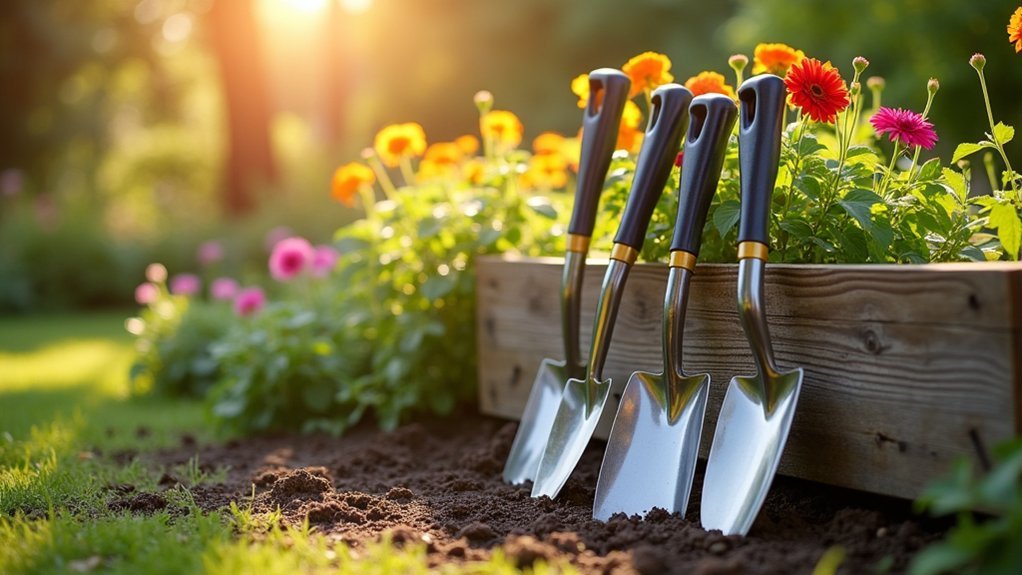
You’ll find grip-enhanced weeders invaluable for tackling stubborn plants without straining your hands or wrists.
The extended pruner with its rotating head provides versatile cutting positions so you can safely trim without awkward reaching or bending.
Telescopic pruners adapt to different heights, letting you trim both low-growing shrubs and higher branches from a comfortable standing position.
These versatile tools form the backbone of an accessible garden setup, eliminating the need to kneel or overreach during regular maintenance tasks.
Grip-Enhanced Weeders
For gardeners with limited mobility, grip-enhanced weeders represent a game-changing innovation that transforms the often challenging task of weeding into a manageable activity.
These tools typically feature durable steel or aluminum construction with specialized claws, tines, or loops that effectively grip weeds at their roots.
You’ll find models like the Fiskars Stand-up Weeder with four serrated claws and an easy-eject mechanism that eliminates the need to bend down.
Many options offer ergonomic, offset handles to reduce wrist strain and non-slip grips that maintain control even in wet conditions.
The CobraHead Long Handle excels at removing weeds with matted roots, while the Garden Ninja Loop Weeder cuts weeds at soil level without damaging nearby plants.
With handles extending from 34 to 72 inches, these tools are specifically designed to reduce back strain for users who have difficulty bending.
Look for adjustable or telescopic designs that can be customized to your height and gardening needs.
Telescopic Pruners That Adapt
While gardening brings joy to many, reaching high branches or distant plants can be particularly challenging for those with mobility limitations. Telescopic pruners offer an ideal solution, extending your reach without ladders or excessive stretching.
These adaptive tools feature adjustable lengths and, in some models, rotating cutter heads for enhanced maneuverability. You’ll appreciate how they eliminate bending and reduce joint strain while keeping gardening tasks accessible from a standing position.
When selecting your pruner, consider models like the Gardena Starcut 410 Plus or ARS Long Reach for reliable performance. The Fiskars UP86 provides exceptional reach with its up to 4m extension capability, ideal for tackling the tallest garden tasks. Focus on weight, balance, and necessary reach for your specific garden.
Some options include saw attachments for thicker branches, adding versatility to your toolkit.
Remember to maintain your pruner regularly, ensuring the cutting edge stays sharp for effortless gardening year-round.
Ergonomic Hand Tools for Arthritis and Joint Conditions
People with arthritis and joint conditions often struggle with traditional gardening tools, which can cause pain and limit their enjoyment of the garden. Ergonomic tools can help you maintain a neutral hand position, reducing strain on painful joints while allowing you to continue gardening. The Peta Easi-Grip product line offers specialized tools designed specifically for gardeners with arthritis.
| Tool Type | Benefits | Best Features |
|---|---|---|
| Trowels | Reduces wrist strain | Cushioned, angled handles |
| Pruners | Minimizes hand fatigue | Ratcheting mechanism |
| Hoes | Decreases joint pressure | Extended, padded grips |
| Cultivators | Lessens required force | Ergonomic handle design |
For best results, combine these tools with supportive techniques like gardening in short intervals, switching between tasks, and wearing assistive gloves. Adding rubber sleeves to handles can further improve grip and comfort, making your gardening experience more enjoyable.
Raised Beds and Container Gardens: Design Considerations
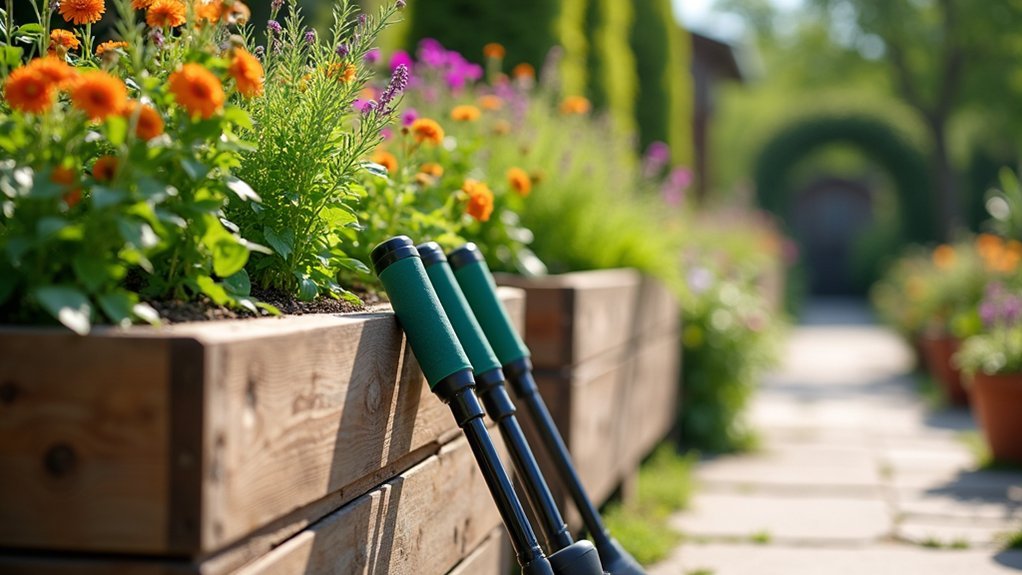
Gardeners with mobility challenges can greatly improve their gardening experience through thoughtfully designed raised beds and container gardens.
When planning your raised beds, consider height requirements—approximately 24 inches high for wheelchair users, while others might prefer heights that eliminate bending or kneeling.
Ensure your beds are 3-4 feet wide with 4-foot pathways between them for easy access. Position beds where they’ll receive 6-8 hours of sunlight for sun-loving plants. For greater independence, incorporate bench seating around the perimeter.
Container gardens offer excellent flexibility, allowing you to follow the sunlight throughout the day. For those with limited strength, consider using lightweight plastic containers that are easier to move yet still provide adequate growing space.
Both options can be crafted from repurposed materials like pallets or old dressers, making them cost-effective solutions. The key benefit? You’ll maintain your gardening passion while reducing physical strain.
Specialized Seating Options for Garden Comfort
Multi-position garden seats offer you adjustable height and swivel capabilities, reducing joint strain while keeping gardening tasks within comfortable reach.
Rolling garden benches eliminate the need for repeated standing and sitting, allowing you to glide effortlessly between planting areas while maintaining proper posture. TheXceptional Wheelie Easy-up Garden Stool features flat-free tires that ensure smooth mobility across various garden terrains.
These specialized seating options include helpful features like integrated handles for easier shifts, weight capacities up to 240 pounds, and convenient storage for tools or drinks.
Multi-Position Garden Seats
Comfort and accessibility merge perfectly in multi-position garden seats, offering specialized support for those with mobility challenges.
These versatile seats feature adjustable heights and angles that accommodate your specific needs, reducing strain during extended gardening sessions.
You’ll appreciate the ergonomic design with full back support and movable armrests that provide stability as you work.
Many models include non-slip bases for safety on uneven terrain and built-in storage for keeping tools within reach.
Choose from lightweight, portable options with handles or wheels for easy relocation around your garden.
Available in weather-resistant materials like wood, metal, or plastic, they’re built for durability with minimal maintenance required.
The folding mechanisms on some models make storage simple when not in use, ensuring your garden remains tidy and organized.
Multi-position garden seats can be strategically placed at various heights to create visual interest throughout your landscape while making gardening more accessible.
Rolling Garden Benches
While stationary seating provides stability, rolling garden benches offer unparalleled freedom of movement for gardeners with mobility challenges.
You’ll appreciate how these versatile tools eliminate excessive bending and stretching while providing comfortable seating throughout your gardening session.
Most rolling benches feature durable construction that withstands various weather conditions while offering several key advantages:
- Adjustable height options that accommodate different tasks and user requirements
- Built-in storage compartments for keeping essential tools within arm’s reach
- Smooth-rolling wheels that navigate various terrain types with minimal effort
- Ergonomic seating surfaces designed to reduce back strain during extended use
Whether you’re tending to your hydroponic system, working in a greenhouse, or maintaining your home garden, these mobile workstations maximize efficiency while minimizing physical strain. Quality models typically include locking mechanisms to prevent unwanted movement when you’re focused on gardening tasks.
Watering Solutions for Limited Strength and Stamina
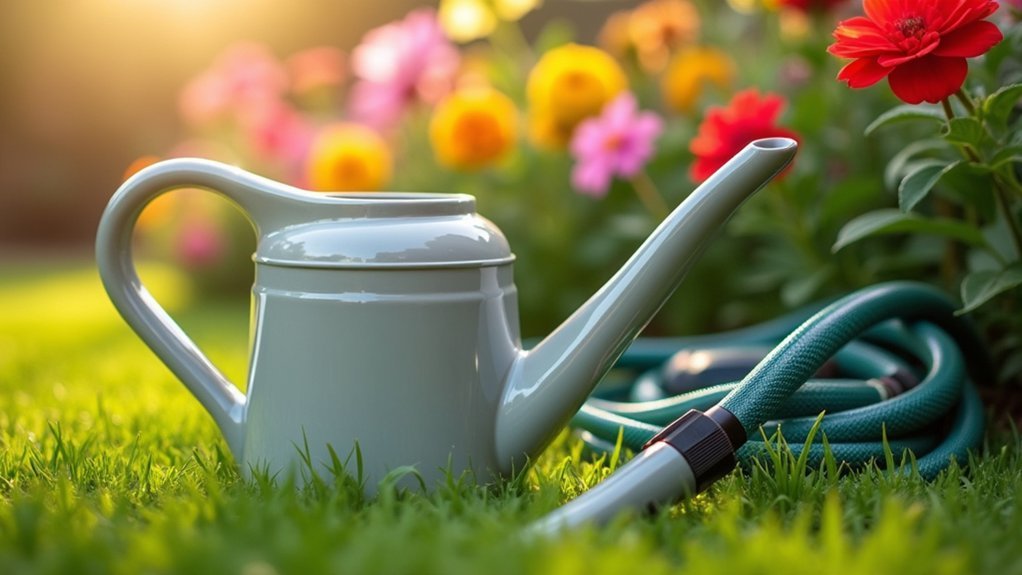
For gardeners with limited mobility, traditional watering methods can quickly drain energy and cause strain. Automatic watering systems eliminate daily manual watering while ensuring your plants receive consistent hydration.
Lightweight watering cans with long spouts and push-button releases reduce arm and back strain. You’ll appreciate drip irrigation kits that efficiently distribute water with minimal effort. Wheelchair users can benefit greatly from these watering adaptations, making garden maintenance more accessible from a seated position. These systems can be customized to your specific garden needs—whether you’re tending a few pots or larger garden beds.
Look for ergonomic handles and lightweight materials in your watering tools. Time-saving features like moisture sensors and programmable schedules allow you to enjoy your garden without overexertion.
You’ll conserve energy while maintaining independence in your gardening routine. Best of all, you’ll spend less time watering and more time enjoying your garden.
Navigating Your Garden: Pathways and Accessibility
When creating garden pathways, you’ll need at least 36 inches of width to accommodate wheelchairs and walkers comfortably.
Your path’s surface material plays an essential role in accessibility, with options like concrete providing durability and necessary traction for mobility aids. Resin-bound gravels can be an excellent alternative that offers both stability and permeability while creating an attractive garden aesthetic.
Consider installing wider paths in key garden areas to allow for side-by-side movement and social interaction while gardening.
Pathway Width Matters
The right pathway width can mean the difference between an accessible garden and a frustrating maze. While ADA standards require a minimum of 36 inches for basic wheelchair navigation, aim for 42 inches when possible to guarantee comfortable movement throughout your garden.
For truly accessible garden paths, consider these key dimensions:
- 32-36 inches – Absolute minimum width, acceptable only for short stretches
- 42 inches – Comfortable single-direction traffic with some maneuverability
- 48 inches – Minimum width for wheelchair turning areas
- 60 inches – Ideal for two-way traffic or making U-turns
Don’t forget to incorporate wider turning platforms at regular intervals and keep pathways clear of obstructions. Regular maintenance should include inspecting paths for uneven surfaces that could create hazards for those with mobility limitations.
Your garden’s accessibility depends as much on pathway design as it does on the tools you’ll use.
Surface Stability Solutions
Stable, accessible pathways form the foundation of any mobility-friendly garden, allowing everyone to navigate your outdoor space safely and independently.
Choose concrete or asphalt for maximum durability and wheelchair support, or consider rubberized surfaces that reduce fall impact and fatigue.
Maintain gentle slopes under 5% to prevent tipping hazards, and install proper drainage to avoid slippery puddles.
Well-defined edges using stone or wood borders help guide wheels and provide tactile feedback for those with visual impairments.
Texture matters—opt for surfaces with enough grip to prevent slipping but smooth enough for mobility aids.
Regular maintenance is essential; promptly repair cracks and remove debris that could cause accidents.
Don’t forget to integrate rest areas at intervals for those who need breaks while enjoying your garden.
Student organizations like the Disabled Students Organization have highlighted that gravel pathways often remain challenging for wheelchair users and mobility scooters, making the case for smoother surface alternatives.
Tool Modifications for Wheelchair Users
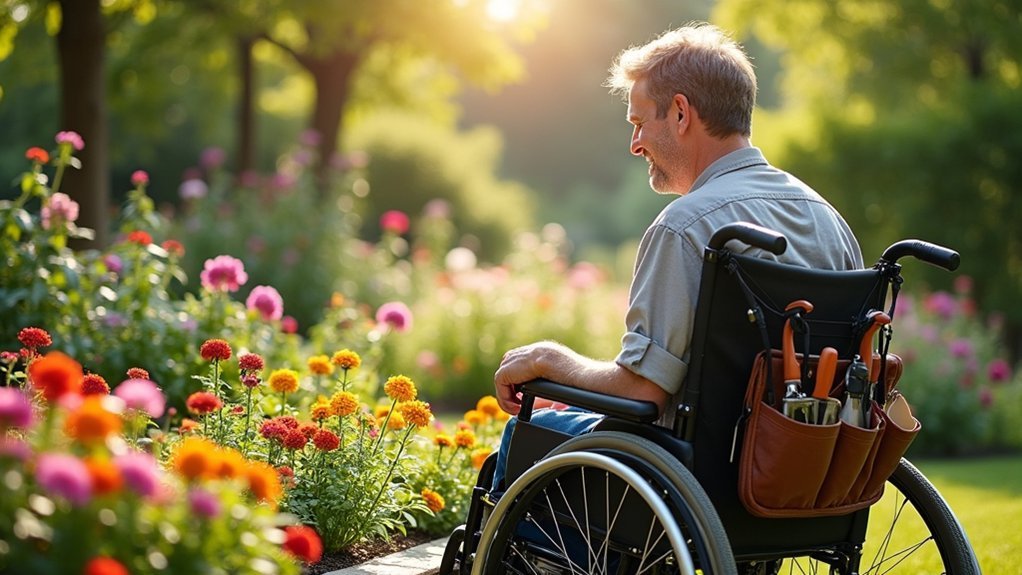
Wheelchair users seeking to enjoy gardening need specialized tool modifications that enhance accessibility while maintaining independence. Adaptive tools designed for seated gardening can greatly reduce strain and frustration while maximizing your gardening capabilities.
- Wheelchair-mounted options: Consider attachable watering devices and tool holders that keep equipment within easy reach, eliminating the need to carry items on your lap.
- Extended reach tools: Telescopic handles and long-reach pruners let you access plants without overextending or compromising stability. These tools should be used alongside slip-resistant matting to prevent items from rolling away during your gardening activities.
- Lightweight alternatives: Tools crafted from aluminum or carbon fiber reduce fatigue during extended gardening sessions.
- Ergonomic grips: Padded, non-slip handles accommodate various grip strengths and prevent tools from slipping when your hands tire.
Year-Round Gardening With Mobility Challenges
Regardless of changing seasons, gardening with mobility limitations can remain a fulfilling activity when you implement thoughtful adaptations throughout the year.
Use coveralls and plant covers during winter to protect your garden while keeping snow-free pathways for continued access.
Select season-appropriate plants to guarantee your garden thrives year-round. During summer, focus on hydration and pest management, while spring and autumn call for different care routines. Remember to pace yourself appropriately by using a timer to limit work sessions based on your comfort level.
Don’t forget to install sunshades for protection during hot days.
For consistent comfort, place benches strategically throughout your garden for regular rest periods.
Consider joining community gardening programs for additional support and knowledge-sharing.
Always consult your healthcare provider before undertaking new or strenuous gardening activities, especially as seasons change.
Creating a Sustainable Garden Practice With Limited Mobility
Creating a sustainable garden practice while managing mobility limitations requires thoughtful planning and strategic adaptations.
You’ll conserve both environmental resources and your own energy by implementing smart design choices that work with your body’s capabilities. Ensuring pathway width accommodates mobility devices is essential for independent navigation throughout your garden space.
Design your garden to minimize unnecessary movement by grouping plants with similar needs together and positioning frequently tended plants within easy reach. You’ll find gardening becomes more manageable and enjoyable.
- Install drip irrigation or soaker hoses to automate watering, reducing physical effort while conserving water.
- Use raised beds at 2-3 feet height with 2-3 feet width for ideal accessibility.
- Apply mulch regularly to suppress weeds and retain soil moisture, cutting maintenance demands.
- Incorporate rolling garden seats to move efficiently between garden areas without strain.
Frequently Asked Questions
How Do I Adapt Existing Gardening Tools on a Budget?
You can adapt existing gardening tools cheaply by adding foam or rubber grips, attaching PVC pipe extensions, repurposing household items for cushioning, and using DIY tutorials online to modify tools for your specific needs.
Can Adaptive Gardening Equipment Be Used by Children With Disabilities?
Yes, adaptive gardening equipment is perfect for children with disabilities. You’ll find child-sized tools with ergonomic handles, lightweight materials, and extended reaches that can help your child garden independently and build important skills.
Are There Gardening Techniques Compatible With Severe Hand Tremors?
Yes, you can garden with severe hand tremors by using ergonomic tools with adaptive handles, practicing seated gardening, taking frequent breaks, and employing stabilizing devices. Modified grip techniques and lightweight tools will also help tremendously.
Which Plants Require Minimal Maintenance for Limited Mobility Gardeners?
You’ll enjoy low-maintenance options like boxwood, hostas, lavender, and sedum for your garden. These plants thrive with minimal care, rarely need pruning, and work well in elevated beds that reduce bending.
How Do Weather Changes Affect Adaptive Gardening Tool Effectiveness?
Weather changes impact tool effectiveness considerably. You’ll need ergonomic handles with slip-resistant grips for rain, lightweight designs for heat, and proper storage during harsh conditions to maintain your adaptive tools’ functionality year-round.
In Summary
You don’t need perfect mobility to enjoy the rewards of gardening. With the right tools and adaptations, you’ll experience both physical therapy and mental peace while cultivating your garden. Remember, it’s not about limitations but finding creative solutions. Start small, adapt as needed, and you’ll soon create a garden that’s not only accessible but truly yours to enjoy throughout the seasons.

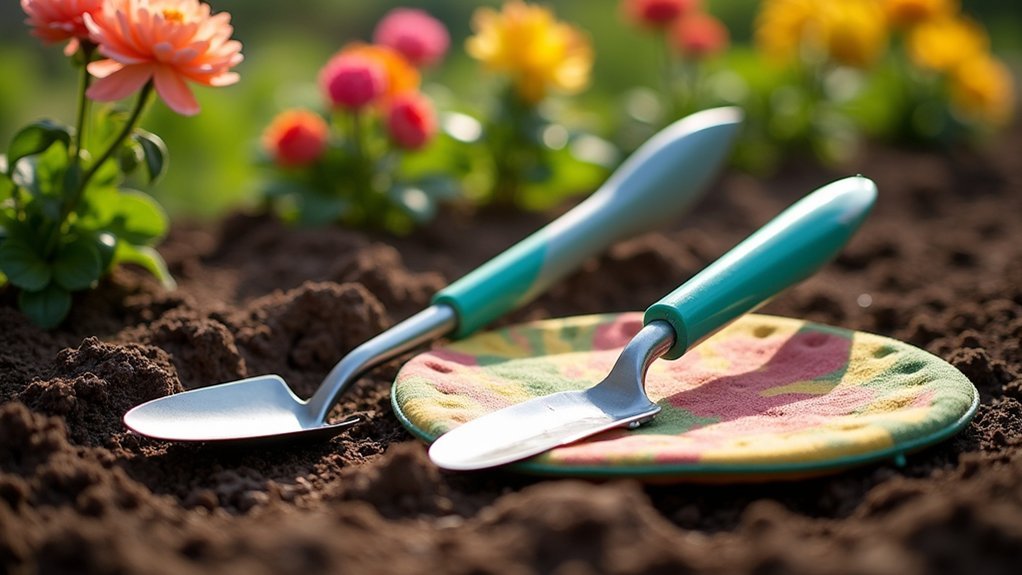



Leave a Reply